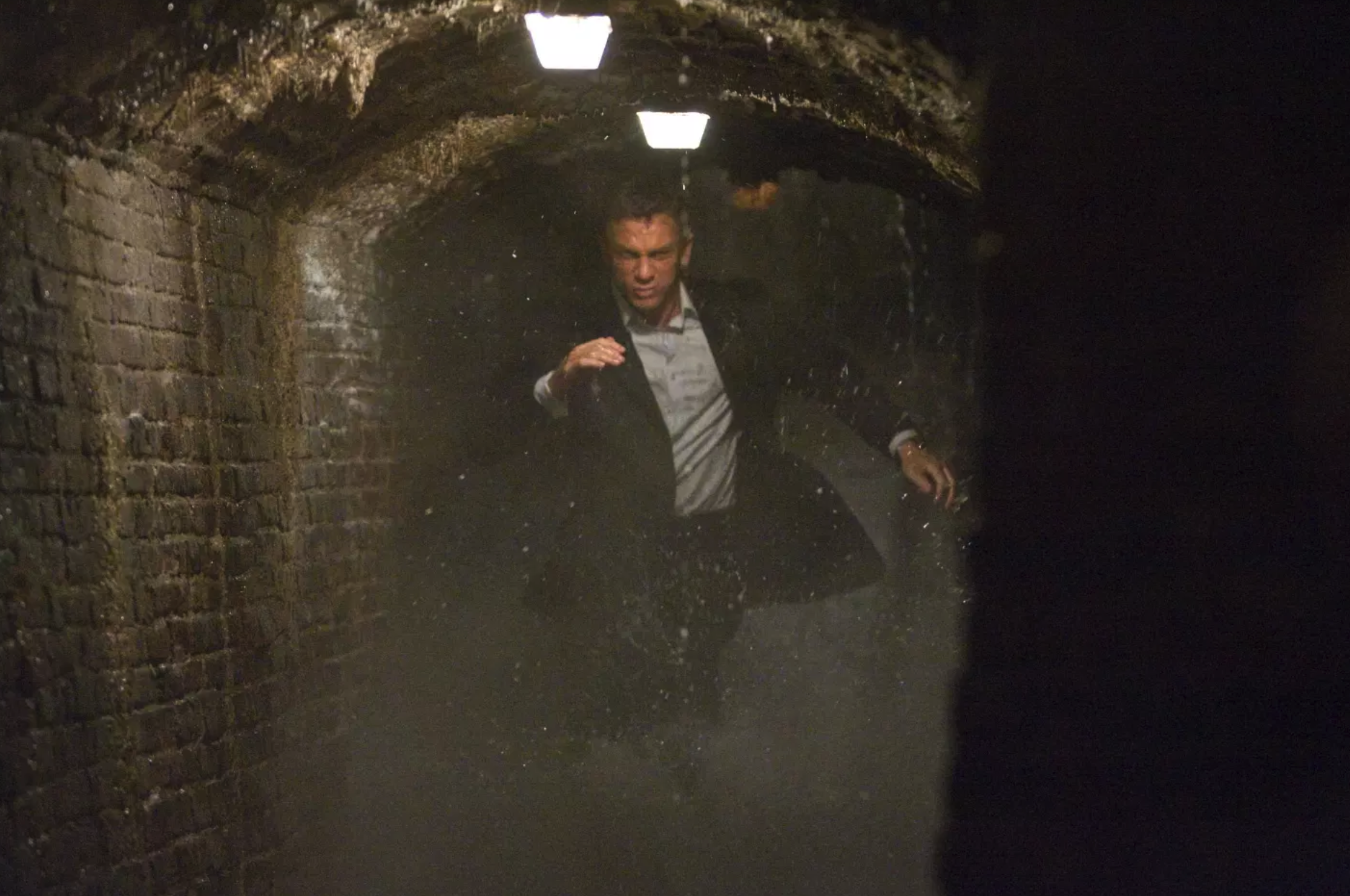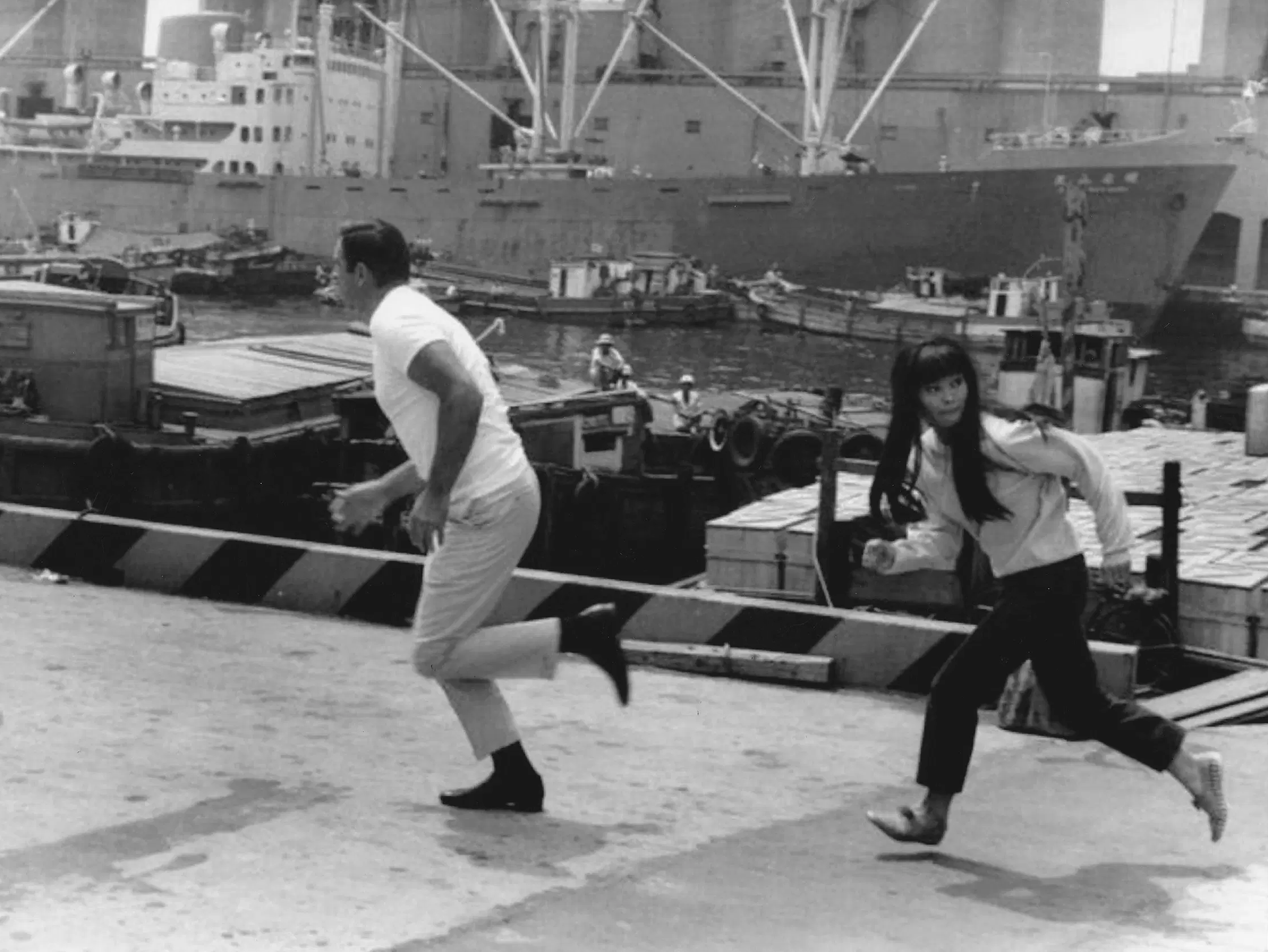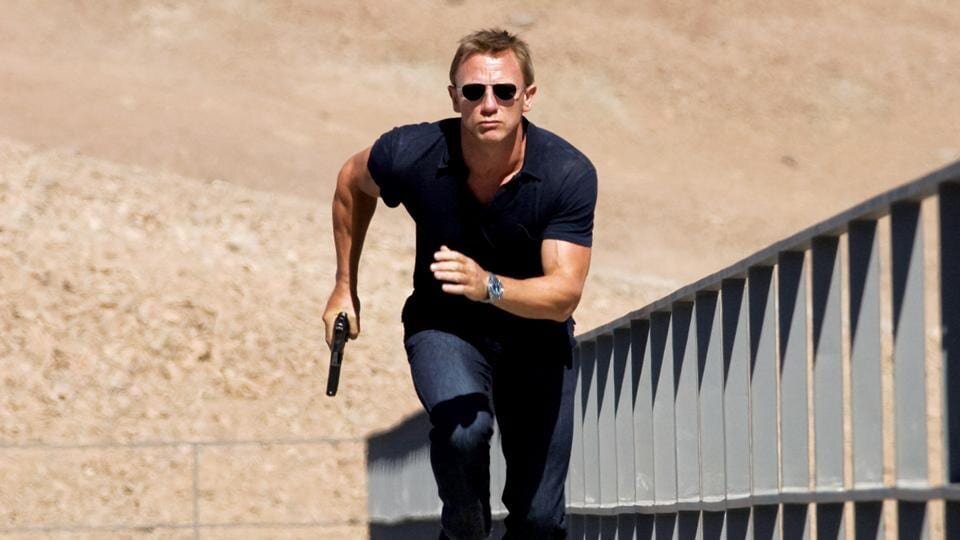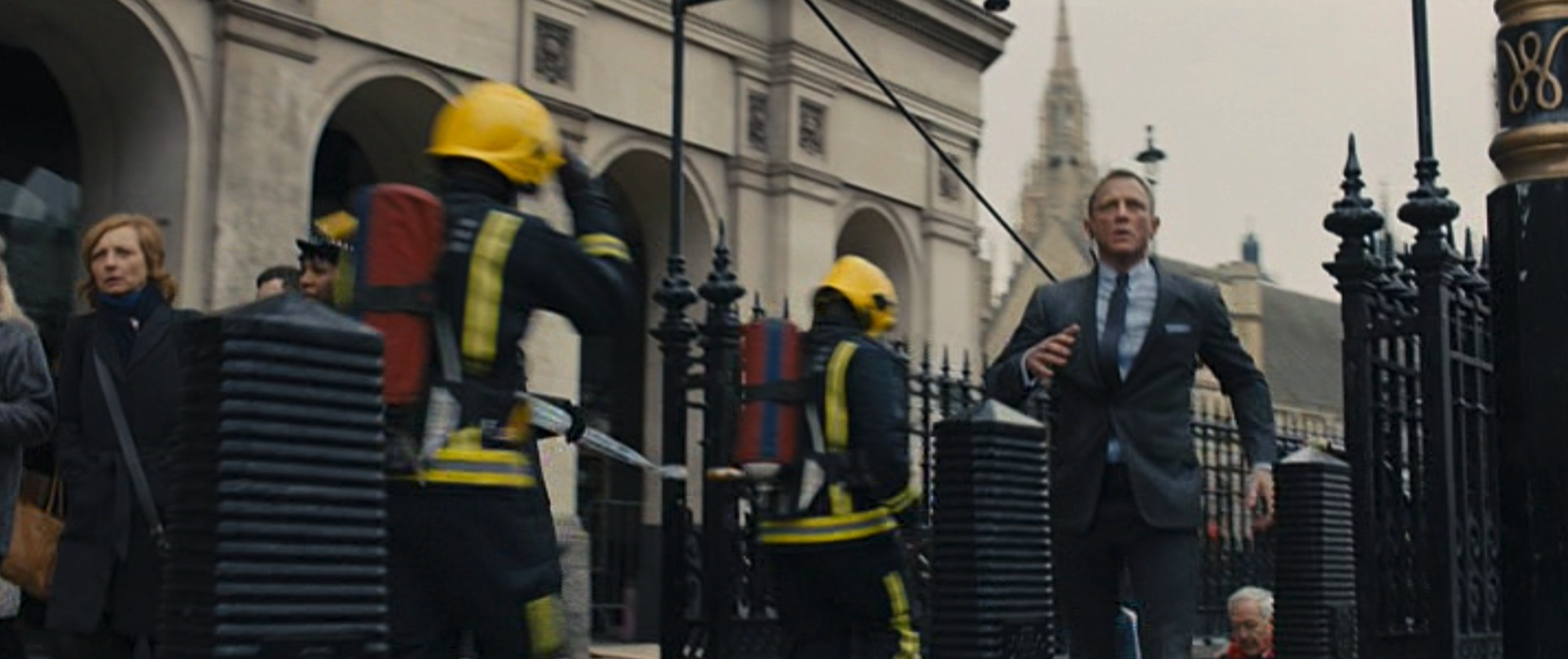He runs while others walk
Running probably saved my life. It’s saved Bond’s more than a few times as well. Here, I look back at his running career - which was not exactly impressive until Daniel Craig brought more metrosexual physicality to the character - and compare it with my own, which started soon after my first viewing of Casino Royale.
This article is also available as a podcast:
I didn’t start running - or any form of exercise for that matter - until I was in my early twenties. I was overweight throughout my time at high school, largely because I was eating my feelings. And I had a lot of feelings, mostly shameful feelings about being gay and therefore worthless.
I credit 2006’s Casino Royale with giving me the push I needed to start taking better care of myself. I didn’t set my sights on a gym bunny body like Daniel Craig’s. I just wanted to lose a stone or two in weight so my clothes fit better and I didn’t have to worry about looking like I had man boobs whenever I tried on a t-shirt. What I didn’t plan for was how good running would make me feel. As I say, I had a lot of feelings, almost exclusively negative ones. I felt like I was in a downward spiral and sought medical assistance. I was prescribed medication after being diagnosed as depressed and I had a series of counselling sessions which barely scratched the surface, although this was mostly because I wasn’t willing to scratch - the whole gay thing didn’t come up, even obliquely.
Medicine and counselling are lifesavers for many but they didn’t work for me. Running, on the other hand, helped a lot. It was one of the things that set me on the path towards coming out at the end of 2009.
The first time I went for a run, it was late at night. I didn’t want anyone to see me. I put on some shorts - not running shorts, as I didn’t own a pair at that point - and a t-shirt and I just ran around the block as many times as it took for me to run out of breath. I must have cut a strange figure doing circuits around a suburban housing estate in khaki cargo shorts close to midnight. But the weird thing is, after about five minutes, I didn’t care if anyone did see me. The act of running had taken me outside of my own head. I could feel the blood pumping around my body, not from anxiety’s all-too-familiar shots of adrenaline but from bodily exertion. When I got back home, my lungs were heaving (I’ve never had good lungs because of a childhood illness) but the physical pain was, bizarrely, enjoyable.
Afterwards, in the shower, I felt vaguely euphoric. It was hard to put my finger on, but - I thought - could this be the endorphin release exercise-fiends had been talking about all these years (and which I had been very cynical of)? Was this something that immediately appealed to me, compared with other sports, because of my gayness?
Queer writer/runner Tim Kaeslin hypotheses that running appeals to gay men because it avoids the awkwardness of contact sports (where you might be accused of something if you grapple another man too enthusiastically), it helps you outrun your queer anxiety (creating the sensation of running away from your troubles) and, unlike sports like football or hockey, it’s not especially gendered.
Some of this resonates with me. In hindsight, I can see that running immediately appealed to me because I could do it alone. I’ve never been into team sports. That sort of competition had just never appealed, perhaps because of the cultures I associate with football, rugby, et al, which I always saw as stereotypically masculine and ‘not for me’.
I sought instead to emulate a version of masculinity I had seen in my favourite fictional characters, particularly James Bond. Aside from the odd sporting game of one upmanship with a villain, Bond is rarely shown playing team sports of the sort I was made to participate in at school. Yes, he plays golf with Goldfinger, but I struggle to imagine him having a kickabout with Kronsteen, or anyone for that matter.
And as for Bond’s running career…? Well, until Craig came along, it wasn’t exactly inspirational…
Moves like a panther
The song Thunderball opens with the line ‘He always runs while others walk’, which most take to be referring to Bond rather than the villain, Largo. Perhaps we should take it as a metaphor either way: neither man is especially fast on their feet. Connery was famously described by Cubby Broccoli’s wife Dana as “moving like a panther”, but he rarely moves very quickly. If Connery’s Bond was a panther, he would be a fairly sedate example of this species of wild cat. Panthers can top 50mph over short periods. By comparison, Sean is more like one of my pet cats seriously considering taking another mid-morning nap.
Perhaps the filmmakers realised they had falsely advertised Bond’s running prowess in the lyrics to Thunderball as the next Bond film did feature Connery running. The highlight of You Only Live Twice’s fight at Kobe docks is the helicopter shot tracking Bond as he runs across the warehouse rooftop, although the distance of the camera does little to enhance the impression that Connery is much of a sprinter. Running only looks fast in close up. And fair play to Connery: he’s running around in a full suit in the middle of the Japanese summer. Production stills show him rehearsing the run in a white t-shirt and you can’t blame him. Although I’ve not been to Kobe, I have been to nearby Osaka in August and it was sweltering. The prospect of running through that humidity in anything other than my birthday suit would not have been a welcome one.
In comparison with Connery, lithe George Lazenby looks like a runner (or at least someone who could model running gear in an advert) and started his one film tenure by running down the beach to save Tracy from drowning herself and he even runs into the opening titles. He’s pretty pacey around Piz Gloria in the finale as well, but he rarely looks like he’s breaking a sweat. Both he and Connery have that in common: they may be lean and they look fit, but it’s never evident that they engage in any form of exercise to stay that way.
Aside from the odd jog out of harm’s way, Roger was not much of a runner, with the memorable exception of him getting his steps in as he gives chase to Locque in For Your Eyes Only. This is not just to do with age: Moore was in his fifties and octogenarian marathon runners do exist (although most prefer to do their running in shorts and not bell-bottomed trousers).
Dalton, Moore’s younger successor, doesn’t do much running either. He briefly gets a move on in his first appearance in the Gibraltar pre-credits sequence of The Living Daylights but spends most of the time clinging onto the roof of a jeep.
This does point to a trend that emerged over the Brosnan-era though: running featuring in the pre-titles. GoldenEye begins with Bond running. The first we see of the new Bond is his running legs. A low angle shot sells the speed.
At the end of the pre-titles sequence, Brosnan goes hell-for-leather down the runway after the departing plane: his only option of escape. There’s also a brief sprint through the Russian archives midway through the film as Bond tries to escape with Natalya. Tomorrow Never Dies is a very physical film overall but the running is mostly confined to the pre-titles sequence as Bond dashes for cover at the exploding arms bazaar. A boat takes the strain off Bond’s knees in The World Is Not Enough and a hovercraft in Die Another Day. Let’s not talk about the surfboard.
What a contrast then, with the very next Bond film, 2006’s Casino Royale. If these two films were runners, Die Another Day would be someone who has never ran in their life except to catch a bus and Casino Royale is someone who gets their kicks from doing an ultramarathon every weekend.
Born to rundown
I’m sure it’s no accident that I started running around the time I first saw Casino Royale. Daniel Craig runs everywhere in that film. The African Rundown sequence immediately after the title sequence sets the pace with Bond seemingly incapable of tiring. Even walls don’t stop him.
Crucially, we are still invited to identify with this physically fitter Bond because his opposition, the man he’s chasing, is faster and more agile than him. Bond may be out of our league, but his enemy is waaaaaaaay out of our league. If you watch Casino Royale knowing that the enemy is played by Sebastain Foucan, co-founder of the sport of parkour (free-running), the effect is even more heightened. Craig’s Bond may be aspirational but his fitness goals are more attainable than those of his competition. It’s all relative.
Interestingly, the African Rundown chase was originally planned as the pre-titles sequence, making it a companion piece with the pre-titles running of GoldenEye. Maybe it’s a Martin Campbell thing, the director’s method for immediately setting up how physically tough Bond is.
The best sustained running sequence in any Bond film is surely Casino Royale’s chase through Miami International airport. It has the feeling I get when I go on a longer distance run than I am comfortable with where I am constantly on the verge of tiring but somehow keep finding the energy to carry on. The scene is all about persistence and dogged determination. There’s a reason the accompanying score cue by David Arnold is my go to if I find I am flagging while out on a run.
The key difference between the bits of running Bond does in the films prior to Casino Royale and the extended sequences in the 2006 Craig debut is this: in the latter, Bond breaks a sweat. He’s pouring with the stuff. It makes him convincingly vulnerable. Whether he’s more or less ‘masculine’ for this is in the eyes of the receiver. For me, it puts him in the realm of the metrosexual, a straight man with traits of a stereotypical gay man. He’s proud of his body, shows it off a great deal and we get to see how he maintains his fitness. If Craig’s Bond was on Instagram, his feed would be full of shirtless gym selfies.
I think it’s telling that Bond’s clothing in these sequences is far from the iconic tailored formalwear we associate most with the character. In the African Rundown, Craig wears a floral-patterned shirt and a tight, fitted t-shirt. You could argue that the get up is more effective camouflage than a tailored suit but it’s unusual for the character and perhaps a signifier that he has a more metrosexual wardrobe than we are accustomed to. In the Miami International scene too, he’s wearing casual clothing, albeit in darker hues. While neither outfit is suitable running gear, it’s more practical than a suit. A suit connotes immobility, best exemplified by the very last shot of the film.
Wearing a suit doesn’t halt Bond in his tracks completely. Even after a draining showdown across the poker table with Le Chiffre and imbibing a sizeable quantity of gin, a besuited Bond pegs it through the casino and across the car park when he realises Vesper is in danger.
Even if Quantum of Solace doesn’t feature as much running as Casino Royale, it’s no slouch. Much of the pre-publicity features imagery of Craig running, although he doesn’t actually do that much of it in the finale. The more significant action on foot is the chase across Siena’s terracotta-tiled rooftops shortly after the pre-titles.
In contrast, an aesthetically reminiscent sequence at the start of Skyfall has Bond swapping various forms of transport with little need to stay on foot. Skyfall does have a very notable running scene of course, the so-called ‘Tennyson’ sequence, which crosscuts M reading poetry with Bond running past key London landmarks in a race against time to reach her before Silva does. And although Bond crashes into the hearing chamber without a hint of being out of breath, Bond’s apparently effortless exertion symbolises the last gasp of the British Empire. The feeling is that Bond, like Britain and MI6, will endure, albeit coasting along at a gentler, steadier pace: a marathon, not a sprint.
Skyfall is something of a turning point, perhaps symbolised by Bond’s jog across a frozen lake being cut abruptly short. Having someone point a gun at you does, I imagine, cause you to break your stride. Although there’s more to it than just that: it signals the start of Bond’s physical decline, back to something less energetically masculine. Bond is slowing down.
Your knees must be killing you
During Bond’s first meeting with with Silva, Bond plays along with the villain’s seduction routine. During the earlier part of it, Silva tries to highlight Bond’s physical frailty, even treating him to a knee rub (although, if this was a sports massage, he would definitely be crossing the line). Bond rebuffs his advances, leading Silva to deride the “physical stuff” that Bond is so proficient at. The irony is that former MI6 agent Silva is later shown to be very physical himself (particularly in the chase through the London Underground). But in their first scene together, Silva is marked out as the more feminine, queer character, someone you can’t imagine doing anything physical, let alone running. His days of “chasing spies” are behind him, unlike Bond’s (here positioned as the more masculine character). Getting intentionally out of breath still carries gendered connotations.
There is far less running in Spectre than in any of the other three Craig films. Its conspicuous absence in the pre-titles sequence was determined by the actor picking up an injury earlier in the production which meant he had to wear a knee-brace for the rest of the shoot. No more running for him. Although Craig’s injury was the result of staging a fight with Dave Bautista, runners everywhere will sympathise. Although running is about as far away as you can get from the sedentary pace of golf, to borrow a metaphor from that sport, injuries are par for the course.
While physical pain might be excruciating (I get murderous shin splints down my left leg if I overdo it), I find not being able to exercise because of an injury more psychologically damaging. Craig has spoken about this openly in interviews. Regarding rupturing his calf muscles on Skyfall, Craig opened up about the psychological impact of being injured. And when he famously, just after finishing Spectre, told the press he’d rather slash his own wrists than play Bond again this was partly because he felt “physically really low”.
Unsurprisingly, considering his more physical interpretation of the character, Craig has been injured more than any previous Bond. No wonder the others were not quite as keen to go for a run.
Giving Bond a run for his money
James Bond isn’t the only running spy out there these days. It’s hard to picture Ethan Hunt in the Mission: Impossible film series without his arms raised in a pumping motion, moving furiously in time with his legs. There are even (spurious?) rumours that the ‘greatest runner in film’, Tom Cruise, won’t let his co-stars run alongside him on screen. Hunt has some stunning running scenes, my personal favourite being the one from the finale of the third film, with Hunt running the length of a canal outside Shanghai. The scene, shot in one unbroken take, apparently has Cruise clocked at 17mph. (The cue from this scene, by Michael Giacchino, is another I save for when I need an energy boost)
I’m not very interested in running fast. I’m not competing against anyone else. I don’t go in for ‘personal bests’. I’m more of a jogger than a runner. I did once (February, 2009) complete a half marathon in not-exactly-quick two hours and three minutes but I was proud just to finish. I really have to train if I want to get anywhere near 13.1 miles nowadays. Being diagnosed with asthma after a severe respiratory virus five years ago doesn’t help. But I make sure I go out for a few miles three or four times a week. It’s a habit I can’t break and, if I don’t go, I get irritable.
Besides Hunt, the other spy who gives Bond a good run for his money is Jason Bourne. Although I maintain that the Bourne series borrowed more from Bond than the other way around, one of the things Bourne encouraged the Bond producers to do was make him a runner. In the first Bourne film, the character informs his companion that “I know the best place to look for a gun is the cab or the gray truck outside, and at this altitude, I can run flat out for a half mile before my hands start shaking.” Running is an essential ability in the modern movie spy’s toolkit. But unlike Hunt’s speed, Bourne is all about endurance.
in the second Bourne film, running is psychological, with him trying to outrun his past as much in his mind as his body. It’s a scene which has always stuck with me since I saw the film in 2004: Bourne running solo across a beach, attired (somewhat unsuitably) in cargo shorts. Perhaps this also led to my not caring if I looked like an idiot when I went for that first, life-changing run.
Breaking a sweat
In earlier Bond eras, we rarely saw 007 do any physical exercise of any kind, beyond the odd dip in the sea. Even in Fleming’s books he barely did more than a few press ups. It’s all part of the ever-present wish fulfilment of the character: you too can take on the world - and win! - even if you smoke, drink and don’t do any exercise. But Casino Royale was a starting pistol, signalling a change. Although the pace has slackened a little recently, the Craig Bond films show that you at least have to break a sweat to be a true hero. A true hero is someone who inspires others to follow their example. And while I wouldn’t endose living like Bond in every regard, the running is definitely something I would recommend. Thanks for saving my life James.
More on running and issues raised in this piece
My running playlist - featuring music from the best running scenes on film - is on Spotify. You can access ‘Run like a spy’ here: https://open.spotify.com/playlist/1jtAsBWfUcrBUAf368LsNo?si=ClN9nhFxQ_y4fE1urInWlg
I talked about The Bourne Supremacy’s beach-set running scene in detail and its personal significance for me when I guested on the Spy Hards podcast: https://www.spyhards.com/e/011-the-bourne-supremacy-2004/
I explore mental health, shame and its repercussions in several pieces, especially my queer re-view of You Only Live Twice, which contains helpful links: https://www.licencetoqueer.com/blog/queer-re-view-you-only-live-twice
My more detailed discussion of the symbolism of Bond’s ‘Tennyson’ run from Skyfall: https://www.licencetoqueer.com/blog/the-truth-about-tennyson
There are several inspiring stories of queer people finding the courage to come out after taking up running. This one is especially lovely:
https://www.outsports.com/2019/9/4/20804318/jacob-grinwis-boise-state-running-gay-coming-out
This article was originally published in May 2021. This version corrects minor errors.

















